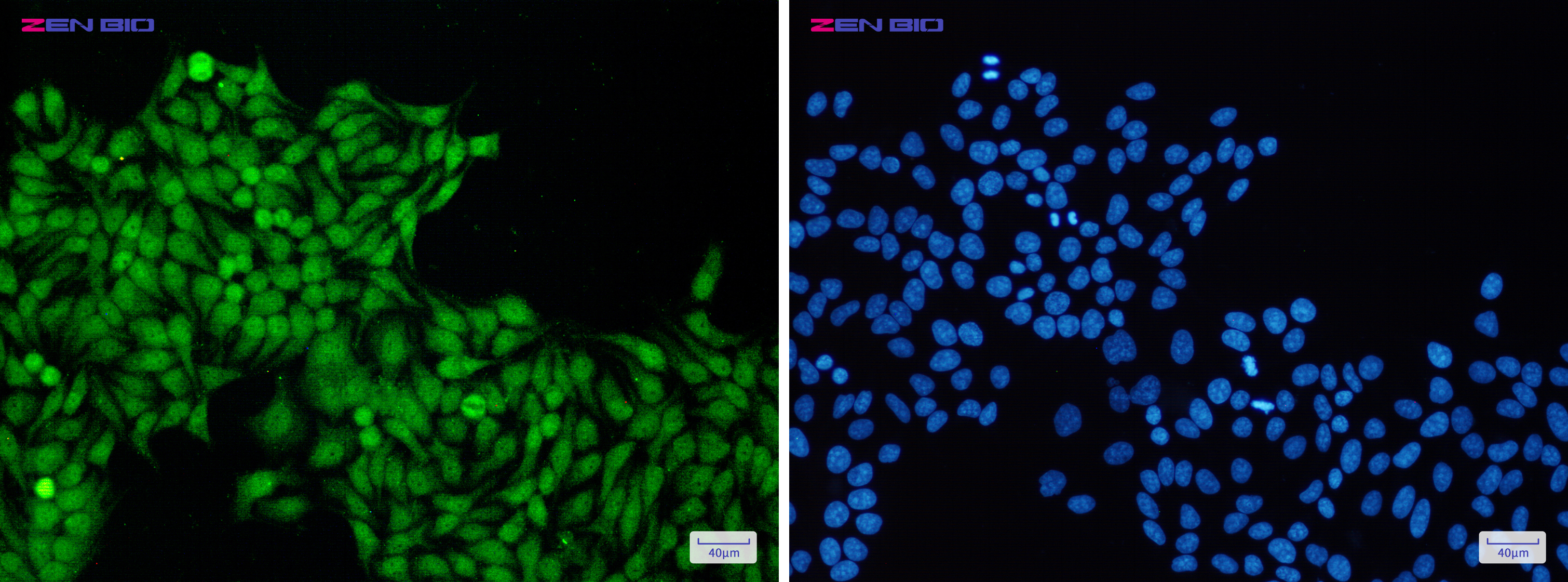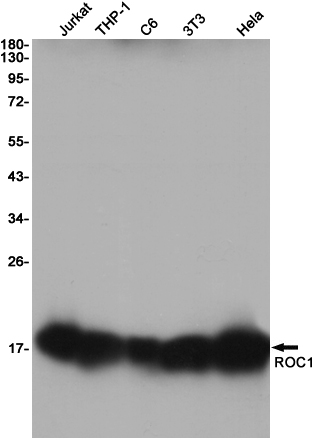-
Product Name
Anti-RBX1 Rabbit antibody
- Documents
-
Description
RBX1 Rabbit polyclonal antibody
-
Tested applications
WB, IHC-P, ICC/IF, FC, IP
-
Species reactivity
Human, Mouse, Rat
-
Alternative names
ROC1; RNF75; BA554C12.1 antibody
-
Isotype
Rabbit IgG
-
Preparation
Antigen: A synthetic peptide of human ROC1
-
Clonality
Polyclonal
-
Formulation
Supplied in 50nM Tris-Glycine(pH 7.4), 0.15M Nacl, 40%Glycerol, 0.01% sodium azide and 0.05% BSA.
-
Storage instructions
Store at -20°C. Stable for 12 months from date of receipt.
-
Applications
WB: 1/1000
IHC: 1/500
ICC/IF: 1/50
FC: 1/20
IP: 1/20
-
Validations

Immunocytochemistry of ROC1(green) in Hela cells using ROC1 Rabbit pAb at dilution 1/50, and DAPI(blue)

Western blot detection of ROC1 in Jurkat,THP-1,C6,3T3,Hela cell lysates using ROC1 Rabbit pAb(1:1000 diluted).Predicted band size:12KDa.Observed band size:12KDa.

Immunohistochemistry of ROC1 in paraffin-embedded Human lung cancer tissue using ROC1 Rabbit pAb at dilution 1/50
-
Background
Swiss-Prot Acc.P62877.E3 ubiquitin ligase component of multiple cullin-RING-based E3 ubiquitin-protein ligase (CRLs) complexes which mediate the ubiquitination and subsequent proteasomal degradation of target proteins, including proteins involved in cell cycle progression, signal transduction, transcription and transcription-coupled nucleotide excision repair (PubMed:10230407, PubMed:10579999, PubMed:15983046, PubMed:16678110, PubMed:19112177, PubMed:19679664, PubMed:23455478, PubMed:27565346, PubMed:29769719, PubMed:11961546, PubMed:22748924). CRLs complexes and ARIH1 collaborate in tandem to mediate ubiquitination of target proteins, ARIH1 mediating addition of the first ubiquitin on CRLs targets (PubMed:27565346). The functional specificity of the E3 ubiquitin-protein ligase complexes depends on the variable substrate recognition components. As a component of the CSA complex promotes the ubiquitination of ERCC6 resulting in proteasomal degradation. Recruits the E2 ubiquitin-conjugating enzyme CDC34 to the complex and brings it into close proximity to the substrate. Probably also stimulates CDC34 autoubiquitination. May be required for histone H3 and histone H4 ubiquitination in response to ultraviolet and for subsequent DNA repair. Promotes the neddylation of CUL1, CUL2, CUL4 and CUL4 via its interaction with UBE2M. Involved in the ubiquitination of KEAP1, ENC1 and KLHL41. In concert with ATF2 and CUL3, promotes degradation of KAT5 thereby attenuating its ability to acetylate and activate ATM.
Related Products / Services
Please note: All products are "FOR RESEARCH USE ONLY AND ARE NOT INTENDED FOR DIAGNOSTIC OR THERAPEUTIC USE"
